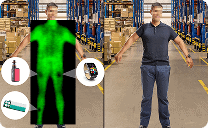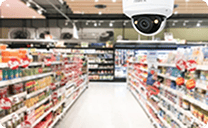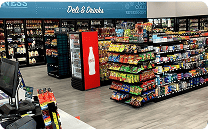In This article
An alarm system uses one or multiple devices to detect intrusions, breaches, or other security events and trigger alerts that notify key personnel or initiate a response. These systems form the foundation of physical security strategies, especially in environments that require continuous monitoring of entry points and sensitive zones.
In most business and industrial settings, alarm systems actively protect assets, ensure employee safety, and deter unauthorized activity. Organizations typically deploy them at building entrances, perimeter access points, server rooms, stock areas, and cash handling zones.
Alarm systems use sensors (to detect movement, door/window openings, or glass breakage), a control panel to manage system logic, communication components to send alerts, and in many cases, audible sirens or strobe lights to deter intruders. When a sensor detects a threat, the system evaluates the event and responds based on preset rules, either by sounding an on-site alarm or sending a remote notification to security personnel or monitoring centers.
Types of Alarm Systems
Many organizations now integrate the alarm with video surveillance and access control. This integration verifies alerts with camera footage, tracks entry attempts, and automates responses like locking doors or alerting authorities.
Alarm systems can vary in complexity and function, depending on the facility’s security needs. Common types include:
- Intrusion Detection Systems that respond to unauthorized access attempts.
- Perimeter Alarms are designed to secure building exteriors, fences, or gates.
- Glass Break or Door/Window Alarms that signal forced entry or tampering.
- Smoke or CO2 alarms are designed to operate in the event of smoke detection or the buildup of gases that are potentially lethal.
- Motion Detection Alarms that monitor movement in restricted zones or after-hours areas.
- Panic and Duress Alarms allow employees to request help in emergencies quickly.
Increasingly, alarm systems can be integrated with video surveillance and access control. This integration makes alerts more actionable by verifying events through camera footage, tracking entry attempts, and creating automated responses like locking doors or alerting authorities.
Smart Alarms and Centralized Monitoring
Today, alarm systems are often cloud-connected and centrally managed, especially in multi-location businesses. These systems allow administrators to arm or disarm alarms remotely, receive real-time alerts across all sites, and access detailed event logs for investigations or audits.
Some alarm platforms use artificial intelligence to reduce false alarms by filtering out routine or non-threatening events. When paired with AI-driven video analytics, businesses gain context-rich notifications that help distinguish between everyday activity and genuine threats.
Why Alarm Systems Matter
For businesses of all sizes, alarm systems help:
- Detect intrusions before they escalate.
- Reduce theft, vandalism, and internal fraud.
- Prevent property damage from smoke, fire, or explosion.
- Improve response times to emergencies.
- Meet compliance standards for security and safety.
- Support investigations with time-stamped alert logs.
Whether you’re securing a retail location, a warehouse, or a multi-site franchise, alarm systems provide constant vigilance—even when no one is watching.
Alarm Systems and DTiQ
The 360iQ platform offers real-time alerting with video verification, cloud analytics, and centralized monitoring for QSR, Retail, and C-store locations, complementing traditional security alarm systems. VDIEOiQ is an intelligent video solution that gives visibility into what’s happening inside and outside each location you manage. Visit our website to learn more.





























